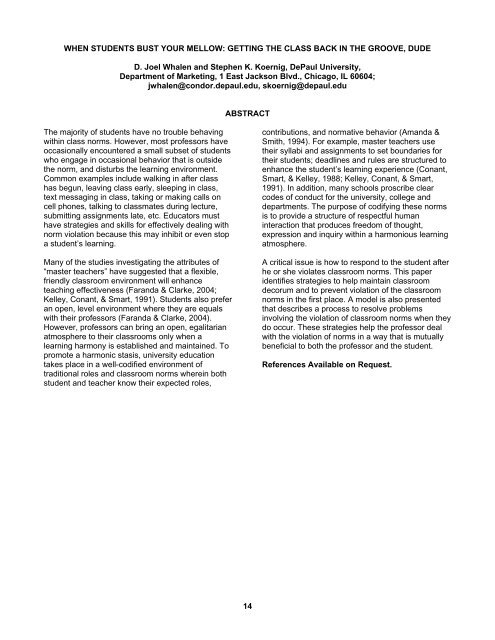2008 - Marketing Educators' Association
2008 - Marketing Educators' Association
2008 - Marketing Educators' Association
Create successful ePaper yourself
Turn your PDF publications into a flip-book with our unique Google optimized e-Paper software.
WHEN STUDENTS BUST YOUR MELLOW: GETTING THE CLASS BACK IN THE GROOVE, DUDE<br />
D. Joel Whalen and Stephen K. Koernig, DePaul University,<br />
Department of <strong>Marketing</strong>, 1 East Jackson Blvd., Chicago, IL 60604;<br />
jwhalen@condor.depaul.edu, skoernig@depaul.edu<br />
The majority of students have no trouble behaving<br />
within class norms. However, most professors have<br />
occasionally encountered a small subset of students<br />
who engage in occasional behavior that is outside<br />
the norm, and disturbs the learning environment.<br />
Common examples include walking in after class<br />
has begun, leaving class early, sleeping in class,<br />
text messaging in class, taking or making calls on<br />
cell phones, talking to classmates during lecture,<br />
submitting assignments late, etc. Educators must<br />
have strategies and skills for effectively dealing with<br />
norm violation because this may inhibit or even stop<br />
a student’s learning.<br />
Many of the studies investigating the attributes of<br />
“master teachers” have suggested that a flexible,<br />
friendly classroom environment will enhance<br />
teaching effectiveness (Faranda & Clarke, 2004;<br />
Kelley, Conant, & Smart, 1991). Students also prefer<br />
an open, level environment where they are equals<br />
with their professors (Faranda & Clarke, 2004).<br />
However, professors can bring an open, egalitarian<br />
atmosphere to their classrooms only when a<br />
learning harmony is established and maintained. To<br />
promote a harmonic stasis, university education<br />
takes place in a well-codified environment of<br />
traditional roles and classroom norms wherein both<br />
student and teacher know their expected roles,<br />
ABSTRACT<br />
14<br />
contributions, and normative behavior (Amanda &<br />
Smith, 1994). For example, master teachers use<br />
their syllabi and assignments to set boundaries for<br />
their students; deadlines and rules are structured to<br />
enhance the student’s learning experience (Conant,<br />
Smart, & Kelley, 1988; Kelley, Conant, & Smart,<br />
1991). In addition, many schools proscribe clear<br />
codes of conduct for the university, college and<br />
departments. The purpose of codifying these norms<br />
is to provide a structure of respectful human<br />
interaction that produces freedom of thought,<br />
expression and inquiry within a harmonious learning<br />
atmosphere.<br />
A critical issue is how to respond to the student after<br />
he or she violates classroom norms. This paper<br />
identifies strategies to help maintain classroom<br />
decorum and to prevent violation of the classroom<br />
norms in the first place. A model is also presented<br />
that describes a process to resolve problems<br />
involving the violation of classroom norms when they<br />
do occur. These strategies help the professor deal<br />
with the violation of norms in a way that is mutually<br />
beneficial to both the professor and the student.<br />
References Available on Request.


